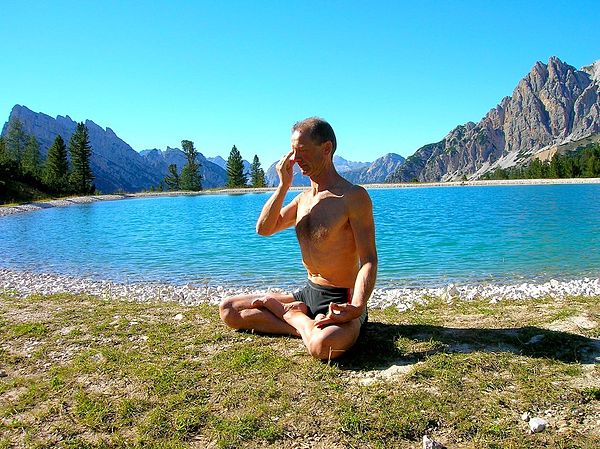Scholars of Sanskrit give us various meanings for the word Prana including breath (or life-force), energy, spirit and soul. A simple meaning of Pranayama is breath control. An important text in Hindu tradition compiled prior to 400 CE, The Yoga Sutras of Patanjali, describes the theory and practice of Yoga. The section on practice, or Sadhana Pada, describes Pranayama – breathing techniques to control the prana or life force – as the fourth of eight branches or limbs of Yoga, preliminary to the subsequent branches of withdrawal of the senses and concentration.
The Bhagavad Gita describes ascetics in pursuit of knowledge through reflection and meditation performing Pranayama as yajna or offering of worship in order to arrive at a stage of complete restraint of breath.
Science informs us that our rate of breathing is regulated by the autonomic nervous system in addition to other body processes, such as blood pressure, heart rate, body temperature and metabolism, this system works autonomously without a person’s conscious effort. When our system is in balance, breathing is parasympathetic; we breathe passively or autonomously. This state is altered by a breathing reflex which is triggered by tension or an external stimulus such as stress, and by the release of that tension. In this reflexive response, our breathing changes from – or back to – our normal autonomous state.
What does all this mean for you? While breathing is autonomous and altered reflexively by external stimuli, conscious breathing is not. It’s now well understood that we can improve our physical wellbeing and concentration, reduce stress levels and anxiety, and be calmer in a crisis by paying attention to our breathing and integrating a few simple breathing practices into our daily routines. Conscious breathing is a modern term coined to describe therapeutic methods that improve the breathing function – methods sages and practitioners of Yoga have been advocating for thousands of years, namely, Pranayama.
A Sanskrit proverb says: For breath is life, and if you breathe well you will live long on earth. Dr. Sheila Patel, Medical Director for the Chopra Center Mind-Body Medical Group agrees. In an overview of the mind-body benefits of Pranayama she says: “Breath is essential to life. It is the first thing we do when we are born and the last thing we do when we leave. In between we take about half a billion breaths. What we may not realize is that the mind, body, and breath are intimately connected and can influence each other. Our breathing is influenced by our thoughts, and our thoughts and physiology can be influenced by our breath. Learning to breathe consciously and with awareness … can be a valuable tool in helping to restore balance in mind and body.” She cites a growing body of evidence documenting the benefits of simple, deep breathing: reduced anxiety and depression, lower and better regulated blood pressure, increased energy levels, muscle relaxation and reduced stress. In addition to “reversing the physical stress response in the body, deep breathing can help calm and slow down the emotional turbulence in the mind,” while adding, “breathing can have an immediate effect on diffusing emotional energy so there is less reactivity to our emotions.”
In addition to simple deep breathing, practitioners recommend four types of yogic breathing or Pranayama: Adham Pranayama or abdominal breathing, Nadi Shodhana or alternate nostril breathing, Ujjayi or ocean’s breath and Bhastrika or energizing breath. There are many other breathing techniques. Each can be learned in a few days. Regular practice improves our abilities and produces better results. You should consult your physician before beginning these practices, as some of them could be undesirable for those with certain medical conditions.
A recent article in Science Daily describes fascinating research to understand the mechanism by which deep breathing helps wellbeing. Breathing directly affects the levels of a natural chemical messenger in the brain called noradrenaline. When produced at the right levels, it acts like a brain fertilizer to help the brain grow new connections. The way we breathe, in other words, directly affects the chemistry of our brains in a way that can enhance our attention and improve our brain health. When stressed, we produce too much of this chemical and when tired, too little. “By focusing on and regulating your breathing you can optimize your attention level and likewise, by focusing on your attention level, your breathing becomes more synchronized,” says the lead researcher. Another article on the science of breathing describes the anatomy of a breath cycle. Recent peer-reviewed research also shows that Pranayama improves quality of life for cancer patients and is an effective intervention in reducing stress and pain among advance stage patients of breast cancer.
You can benefit by making very small changes in your daily habits. If you pause for just two minutes four times a day to focus on your breath and do simple deep breathing, that’s a full hour of deep breathing every week. Integrating 20 minutes of Pranayama in your daily routine will result in perceptible improvement in your physical, mental and emotional wellbeing.
“Breath is the bridge which connects life to consciousness, which unites your body to your thoughts,” says Thích Nhất Hạnh, the Vietnamese Buddhist monk and peace activist, “feelings come and go like clouds in a windy sky. Conscious breathing is my anchor.”
Pranayama: it’s a matter of life and breath!
by | May 14, 2019
